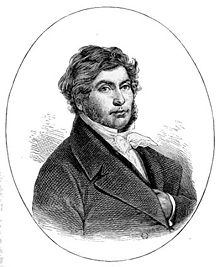Jean-François Champollion
Template:Cleanup-date
Jean-François Champollion (23 December 1790–4 March 1832) was a French classical scholar, philologist, orientalist, and Egyptologist.
Champollion is generally credited as the father of Egyptology. Partly based on some groundwork laid by Thomas Young and William Bankes, Champollion translated parts of the Rosetta stone in 1822, showing that the ancient Egyptian was similar to Coptic, and the writing system was a combination of phonetic and ideographic signs.
He was born at Figeac, Lot, in France, the last of seven children (two of whom were already dead before his birth). He lived in Grenoble for several years, and even as a child showed an extraordinary linguistic talent. By the age of 16 he had mastered a dozen languages and had read a paper before the Grenoble Academy concerning the Coptic language. By 20 he could also speak Latin, Greek, Hebrew, Amharic, Sanskrit, Avestan, Pahlavi, Arabic, Syriac, Chaldean, Persian, and Chinese in addition to his native French.[1] In 1809, he became assistant-professor of History at Grenoble. His interest in oriental languages, especially Coptic, led to his being entrusted with the task of deciphering the writing on the then recently-discovered Rosetta Stone, and he spent the years 1822–1824 on this task. His 1824 work Précis du système hiéroglyphique gave birth to the entire field of modern Egyptology. He also identified the importance of the Turin King List.
His vast interest in Egyptology was originally inspired by Napoleon's Egyptian Campaigns 1798–1801. Champollion was subsequently made Professor of Egyptology at the Collège de France.
In 1828 and 1829, Champollion led the joint Franco-Tuscan expedition to Egypt, together with Ippolito Rosellini, the professor of Oriental Languages at the University of Pisa. He travelled upstream along the Nile and studied an exhaustive number of monuments and inscriptions. The expedition led to a posthumously-published extensive Monuments de l'Egypte et de la Nubie (1845). Unfortunately, Champollion's expedition was blemished by instances of unchecked looting. Most notably, while studying the Valley of the Kings, he irreparably damaged KV17, the tomb of Seti I, by physically removing two large wall sections with mirror-image scenes. The scenes are now in the collections of the Louvre and the museum of Florence.
Exhausted by his labours during and after his scientific expedition to Egypt, Champollion died of an apoplectic attack in Paris in 1832 at the age of 41 and is buried in the Père Lachaise cemetery. His elder brother, Jacques Joseph Champollion-Figeac edited certain of his works; Jacques Joseph's son, Aimé-Louis (1812–1894), wrote a biography of the two brothers.
Egyptian hieroglyphs
Thomas Young was also one of the first who had partly successfully deciphered Egyptian hieroglyphs; by 1814 he had completely translated the "enchorial" (demotic, in modern terms) text of the Rosetta Stone, and a few years later had made considerable progress towards an understanding of the hieroglyphic alphabet. In 1823 he published an Account of the Recent Discoveries in Hieroglyphic Literature and Egyptian Antiquities. Some of Young's conclusions appeared in the famous article "Egypt" he wrote for the 1818 edition of the Encyclopædia Britannica.
When Champollion published his translation of the hieroglyphs, Young praised his work but also stated that Champollion had based his system on Young's articles and wanted that his part should be recognized. Champollion, however, was unwilling to share the credit. In the forthcoming schism, strongly motivated by the political tensions of that time, the British supported Young and the French Champollion. Champollion, whose complete understanding of the hieroglyphic grammar showed some mistakes made by Young, maintained that he had deciphered alone the hieroglyphs. However, after 1826, he did offer Young access to demotic manuscripts in the Louvre, when he was a curator there.
Sources
- ↑ Singh, Simon (2000). The Code Book: The Science of Secrecy from Ancient Egypt to Quantum Cryptography. Anchor. ISBN 0385495323.
Reeves, N (1996), The Complete Valley of the Kings
External links
- Jean-François Champollion at KMT: A Modern Journal of Ancient Egypt
- Resources on Biblical Archaeology
- Key words: Unlocking lost languages "The Keys of Egypt" by Lesley and Roy Atkins, a book on Champollion is reviewed among others in this long Guardian/London Review of Books essay
- Jean-François Champollion at BBC History
Credits
New World Encyclopedia writers and editors rewrote and completed the Wikipedia article in accordance with New World Encyclopedia standards. This article abides by terms of the Creative Commons CC-by-sa 3.0 License (CC-by-sa), which may be used and disseminated with proper attribution. Credit is due under the terms of this license that can reference both the New World Encyclopedia contributors and the selfless volunteer contributors of the Wikimedia Foundation. To cite this article click here for a list of acceptable citing formats.The history of earlier contributions by wikipedians is accessible to researchers here:
The history of this article since it was imported to New World Encyclopedia:
Note: Some restrictions may apply to use of individual images which are separately licensed.
